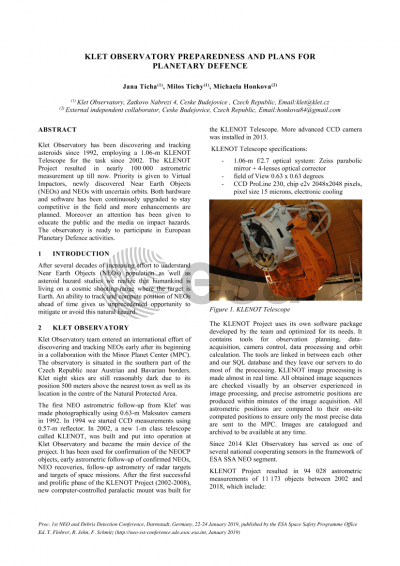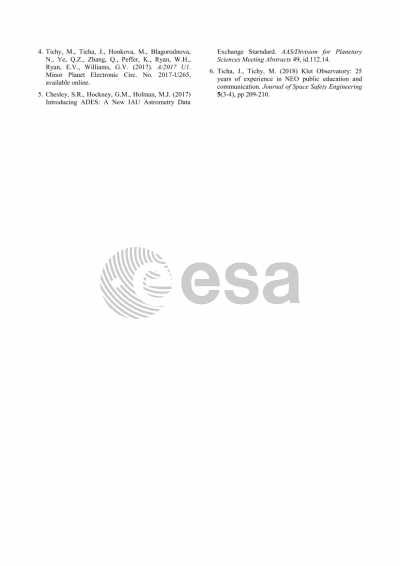Document details

Abstract
After several decades of increasing effort to understand Near Earth Objects (NEO) population as well as asteroid hazard studies we realize that the humankind is living on a cosmic shooting-range where the target is Earth.
Klet Observatory team entered an international effort to discover and tracking NEOs early after its beginning in a collaboration with the Minor Planet Center. The first astrometric follow-up was made photographically using 0.63-m Maksutov camera in 1992. As early as it was possible we started CCD measurements using 0.57-m reflector. Considering increasing importance of an inventory of Near Earth Asteroid population down to 140 meters or less we decided to build a new 1-m class telescope called KLENOT at Klet Observatory. It was put into operation in 2002 and has been used for confirmation of the NEOCP objects, early astrometric follow-up of confirmed NEAs, NEA recoveries, follow-up astrometry of radar targets and targets of space missions. After the first succesfull and prolific phase of KLENOT Project which resulted in tens of thousands of astrometric measurements of NEOs we decided to build a new computer-controled mount for the KLENOT Telescope. Since 2014
Klet Observatory has served as one of several national cooperating sensors in the framework of ESA SSA NEO segment.
The current European road map towards a Planetary Defence System
under ESA leadership becomes a great challenge for us.
We manage 1.06-m KLENOT Telescope equipped with 2k x 2K FLI ProLine
CCD camera and reasonable computer and network capabilities. Its
full observing time is dedicated to our team for NEA and comet follow-up. Klet Observatory is situated in a southern part of the Czech Republic near Austrian and Bavarian borders. Klet night skies are still reasonably
dark due to its position 500 meters above the nearest town as well as
its location in the centre of Natural Protected Area.
Existing and planned progress of Klet Observatory equipment and workflow:
* In order to increase tracking accuracy of the KLENOT telescope the main gearbox of the KLENOT mount was upgraded
* We have incorporated GAIA DR2 astrometric catalogue into our workflow and started to produce astrometric measurements using GAIA DR2 two weeks after the catalog’s publishing.
* We are working on artificial flatfield created as a background estimate to improve signal to noise ratio and measurements precision of our astrometry. The method has been tested and resulted in obtaining astrometric measurements of the first interstellar body 1I/‘Oumuamua and will be accessible as routine part of our processing workflow soon.
* We have augmented our custom observer’s tool with minor planets and comets predictor, which is taking ephemeris of known objects and marks them on viewed image. Since the field of view of KLENOT telescope usually contains several mainbelt asteroids in addition to the observed object, in the next step we plan to automatize the astrometry of these low priority, well-determined objects.
* We are planning to make transition of Klet published astrometry from the standard MPC 80-column format to ADES, which provides additional
functionality over the old format.
* We are planning to improve Klet observation planning tool towards
more importance to the ESA priority list.
We are ready to cooperate in the field of tracking and characterization
NEOs in the framework of ESA-SSP and we are open to further improvement and deeper coordination of European Planetary Defence activities.
Preview





